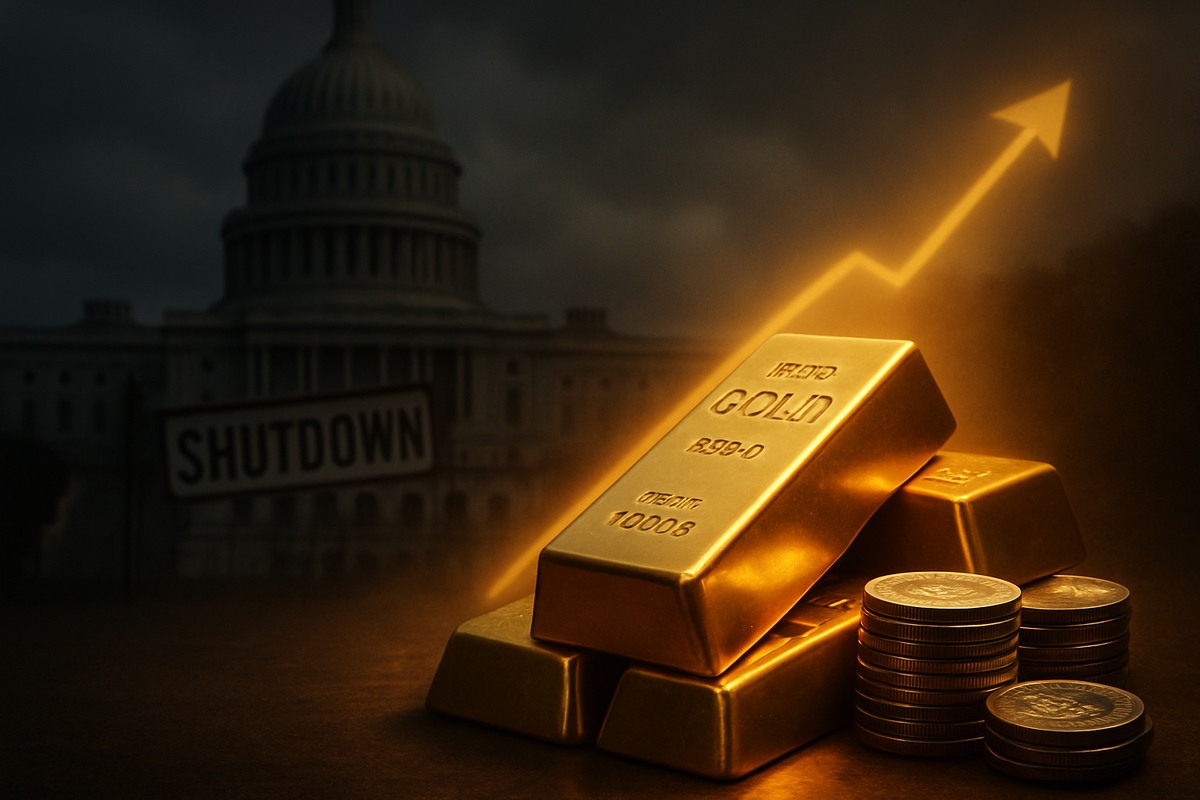
Washington D.C. – October 1, 2025 – The United States federal government has officially entered a shutdown as of 12:01 a.m. EDT on October 1, 2025, marking the first such occurrence since 2018-2019. This fiscal impasse, stemming from deep-seated partisan disagreements over federal spending, foreign aid, and health insurance subsidies, has immediately sent ripples through global financial markets. In a predictable yet pronounced reaction, investors have flocked to traditional safe-haven assets, propelling gold and silver prices to unprecedented highs.
The ongoing political gridlock has fueled an acute sense of economic uncertainty, prompting a significant flight from riskier investments. Gold prices have soared above $3,890 per ounce, reaching record territory for the third consecutive session, with U.S. gold futures hitting an all-time high of approximately $3,922 per troy ounce. Silver has mirrored this upward trajectory, with futures trading over $47 per troy ounce and some reports indicating a more substantial year-to-date increase than gold. This dramatic market response places the Federal Reserve in a precarious position, as it grapples with heightened economic instability and evolving inflation expectations in an already complex monetary policy landscape.
Federal Impasse Triggers Market Turmoil
The current government shutdown unfolded after Congress failed to pass appropriations legislation for the 2026 fiscal year before the September 30th deadline. The breakdown in negotiations was characterized by a chasm between the two major parties on several contentious issues, including the overall federal budget ceiling, continued funding for international conflicts, and the future of key social programs. This political stalemate has paralyzed non-essential government operations, leading to furloughs for hundreds of thousands of federal employees and the suspension of various government services.
The immediate market reaction has been swift and decisive. Beyond the surge in precious metals, the shutdown has contributed to a weakening of the U.S. dollar, as international investors grow wary of America's fiscal stability. The delay in the release of critical economic data, such as the September employment report, further exacerbates market uncertainty, creating a data vacuum that complicates accurate economic assessment. This lack of transparency only strengthens the appeal of tangible assets like gold and silver, which are perceived as reliable stores of value during times of obscured economic outlooks. The timeline leading up to this moment saw weeks of intense, often acrimonious, debates in Congress, with several stop-gap funding measures failing to gain bipartisan support, ultimately culminating in the current shutdown. Key players involved include the White House, congressional leadership from both the Democratic and Republican parties, and various lobbying groups advocating for specific spending priorities.
Mining Giants Poised for Gains, Broader Market Faces Headwinds
The surge in gold and silver prices directly benefits companies engaged in the mining, exploration, and refining of these precious metals. Major gold miners like Newmont Corporation (NYSE: NEM) and Barrick Gold Corporation (NYSE: GOLD) are poised for significant revenue increases as the value of their primary commodities skyrockets. Similarly, silver producers such as Pan American Silver Corp. (NASDAQ: PAAS) and Wheaton Precious Metals Corp. (NYSE: WPM) are likely to see their profitability boosted. These companies, often considered safe-haven investments themselves during periods of economic instability, could experience increased investor interest and potentially higher stock valuations as long as the precious metals rally continues.
Conversely, companies heavily reliant on government contracts or those operating in sectors sensitive to consumer confidence and economic stability face considerable headwinds. Defense contractors, for instance, might experience delays in new project approvals or payment processing. Industries dependent on federal regulatory oversight or data releases could also suffer from operational slowdowns. Furthermore, the broader stock market could experience volatility as the shutdown prolongs, impacting consumer spending and business investment. Financial institutions, while potentially benefiting from increased trading volumes in safe-haven assets, could also face challenges from a weakened economy and potential credit market disruptions if the shutdown's effects deepen. The overall economic uncertainty generated by the shutdown tends to depress investor sentiment for growth-oriented companies and those with less robust balance sheets, making them potential losers in this environment.
Federal Reserve's Tightrope Walk Amidst Uncertainty
The current government shutdown and the subsequent flight to safe-haven assets present a complex challenge for the Federal Reserve. This event fits into a broader trend of increasing geopolitical and domestic economic uncertainty that has plagued global markets in recent years. The Fed's dual mandate of maximizing employment and maintaining price stability becomes significantly harder to achieve when fiscal policy is in disarray. The shutdown's immediate impact, including delayed economic data and dampened consumer confidence, directly influences the Fed's assessment of economic health and future inflation expectations.
Historically, government shutdowns have often led to increased pressure on the Fed to provide monetary stimulus to offset the economic drag. This time, the situation is compounded by pre-existing concerns about persistent inflation, even as the Fed has been on a path of tightening or maintaining higher interest rates. The surge in gold and silver, often seen as an inflation hedge, could signal that investors are anticipating either higher inflation due to potential future monetary easing or a loss of confidence in traditional fiat currencies and government stability. This market reaction could force the Fed to re-evaluate its immediate interest rate strategy, potentially leaning towards cuts sooner than anticipated to mitigate the shutdown's economic fallout, even if inflation remains a concern. Regulatory implications are also significant; a prolonged shutdown could delay critical financial regulations or oversight, potentially creating systemic risks. Comparisons to past shutdowns, such as those in 2013 or 2018-2019, suggest that while initial market reactions can be sharp, the long-term economic impact depends heavily on the duration of the shutdown. However, the current environment of elevated inflation and a more hawkish Fed stance makes this shutdown's implications potentially more severe.
Navigating the Path Ahead: Short-term Volatility, Long-term Shifts
In the short term, the market will remain highly sensitive to any news regarding the government shutdown's resolution. Continued political deadlock will likely sustain the upward pressure on gold and silver prices, while a swift resolution could see a partial reversal as risk appetite returns. Investors should anticipate ongoing volatility across equity and bond markets. The Federal Reserve's next move will be under intense scrutiny, with market participants closely watching for any signals regarding potential interest rate adjustments. A prolonged shutdown could significantly impact Q4 2025 GDP growth, pushing the Fed towards more accommodative monetary policy sooner than previously expected, despite inflationary pressures.
Looking further ahead, this event could catalyze a strategic pivot for businesses and investors. Companies with robust balance sheets and diversified revenue streams will be better positioned to weather the uncertainty. For investors, the event underscores the importance of portfolio diversification, with precious metals serving as a critical hedge against political and economic instability. Market opportunities may emerge in sectors resilient to government inaction or those that benefit from a flight to quality. Challenges include potential credit rating downgrades for the U.S., which could have far-reaching implications for global financial markets. Potential scenarios range from a quick, politically negotiated settlement leading to a modest market rebound, to a protracted shutdown causing significant economic damage and forcing aggressive monetary interventions from the Fed.
The Enduring Impact of Instability
The 2025 government shutdown serves as a potent reminder of how political dysfunction can directly translate into financial market volatility and economic uncertainty. The dramatic surge in gold and silver prices highlights investors' deep-seated need for safe-haven assets when confidence in government stability and economic outlook wanes. For the Federal Reserve, this event presents a formidable challenge, potentially forcing a difficult balancing act between addressing economic stagnation caused by the shutdown and managing persistent inflation expectations.
Moving forward, market participants will be keenly observing the duration of the shutdown, any legislative developments, and critically, the Federal Reserve's response. The lasting impact could be a reinforcement of the role of precious metals in diversified portfolios and a renewed focus on fiscal responsibility from policymakers. Investors should remain vigilant, paying close attention to macroeconomic indicators, central bank communications, and geopolitical developments. The current environment underscores that political stability is an increasingly vital, yet fragile, component of overall market health.
This content is intended for informational purposes only and is not financial advice






